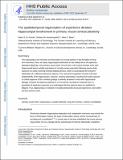| dc.contributor.author | Finnie, Peter SB | |
| dc.contributor.author | Komorowski, Robert W | |
| dc.contributor.author | Bear, Mark F | |
| dc.date.accessioned | 2023-03-23T18:37:05Z | |
| dc.date.available | 2023-03-23T18:37:05Z | |
| dc.date.issued | 2021 | |
| dc.identifier.uri | https://hdl.handle.net/1721.1/148688 | |
| dc.description.abstract | The hippocampus and neocortex are theorized to be crucial partners in the formation of long-term memories. Here, we assess hippocampal involvement in two related forms of experience-dependent plasticity in the primary visual cortex (V1) of mice. Like control animals, those with hippocampal lesions exhibit potentiation of visually evoked potentials after passive daily exposure to a phase-reversing oriented grating stimulus, which is accompanied by long-term habituation of a reflexive behavioral response. Thus, low-level recognition memory is formed independently of the hippocampus. However, response potentiation resulting from daily exposure to a fixed sequence of four oriented gratings is severely impaired in mice with hippocampal damage. A feature of sequence plasticity in V1 of controls, which is absent in lesioned mice, is the generation of predictive responses to an anticipated stimulus element when it is withheld or delayed. Thus, the hippocampus is involved in encoding temporally structured experience, even within the primary sensory cortex. | en_US |
| dc.language.iso | en | |
| dc.publisher | Elsevier BV | en_US |
| dc.relation.isversionof | 10.1016/J.CUB.2021.06.079 | en_US |
| dc.rights | Creative Commons Attribution-NonCommercial-NoDerivs License | en_US |
| dc.rights.uri | http://creativecommons.org/licenses/by-nc-nd/4.0/ | en_US |
| dc.source | PMC | en_US |
| dc.title | The spatiotemporal organization of experience dictates hippocampal involvement in primary visual cortical plasticity | en_US |
| dc.type | Article | en_US |
| dc.identifier.citation | Finnie, Peter SB, Komorowski, Robert W and Bear, Mark F. 2021. "The spatiotemporal organization of experience dictates hippocampal involvement in primary visual cortical plasticity." Current Biology, 31 (18). | |
| dc.contributor.department | Massachusetts Institute of Technology. Department of Brain and Cognitive Sciences | en_US |
| dc.relation.journal | Current Biology | en_US |
| dc.eprint.version | Author's final manuscript | en_US |
| dc.type.uri | http://purl.org/eprint/type/JournalArticle | en_US |
| eprint.status | http://purl.org/eprint/status/PeerReviewed | en_US |
| dc.date.updated | 2023-03-23T18:08:11Z | |
| dspace.orderedauthors | Finnie, PSB; Komorowski, RW; Bear, MF | en_US |
| dspace.date.submission | 2023-03-23T18:08:13Z | |
| mit.journal.volume | 31 | en_US |
| mit.journal.issue | 18 | en_US |
| mit.license | PUBLISHER_CC | |
| mit.metadata.status | Authority Work and Publication Information Needed | en_US |
